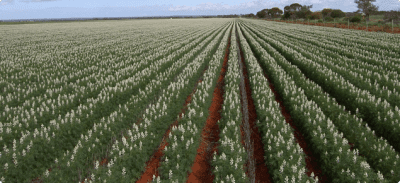
A Western Australian lupin crop. Photo: DPIRD
PRODUCTION from the lupin harvest now underway across southern Australia is forecast at 482,700 tonnes, 27 per cent below the industry estimate for the 2018/19 crop, according to the latest Pulse Australia crop report.
While tonnage produced in New South Wales has gone up by 10,000t to 90,000t, a dry spring in Western Australia, which produces more lupins than the country’s eastern states combined, has reduced the national pulse forecaster’s estimate by 12pc.
| ABARES 2018 | PA Aug 2019 | PA Nov 2019 | |
|---|---|---|---|
| NSW | 37,500 | 80,000 | 90,000 |
| Vic | 20,000 | 36,700 | 36,700 |
| SA | 35,000 | 46,000 | 46,000 |
| WA | 600,000 | 387,000 | 310,000 |
| Total tonnes | 692,500 | 549,700 | 482,700 |
Table 1: ABARES Sep 2019 estimates for 2018/19, and Pulse Australia’s current and previous estimates for 2019/20.
Market for WA
CBH general manager marketing and trading Jason Craig said CBH has seen an increase in feedgrain demand from customers in the eastern states.
“The majority of this demand has been for wheat and barley, and there has also been select demand for lupins,” Mr Craig said.
“We anticipate east coast demand will remain.
“However, WA lupin production is down significantly this season, which will impact our ability to meet that demand.”
In its most recent harvest report released on Friday, CBH Group said the global market for lupins has been “surprisingly robust” because of customers requiring a small percentage of lupins in their feed rations for consistency.
“This has resulted in the international market paying higher values than the domestic, a market dynamic not seen for a number of years,” the report said.
Perth company Independent Grain Handlers (IGH) is a major supplier of lupins to domestic and export markets, and last year sold considerable bulk and containerised tonnage into Queensland and Victoria to help satisfy drought-driven feed demand.
“It doesn’t happen every year, but last year was massive,” IGH principal Rob Proud said.
Mr Proud said east-coast demand last year helped to lift WA prices, but new-crop sales of WA lupins into eastern states were not expected at this stage.
“The WA lupin crop could be one third of what it was last year, feeding animals here is quite lucrative, and we’ve got our own drought to factor in.”
Prices strong
On Friday, CBH Group said lupin prices have continued to lift, with levels now in the $430s per tonne free-in-store Kwinana.
This is well above the long-term average price in the mid $300s/t, and above the $400/t benchmark price at which consumers will switch to cheaper alternative protein sources like soymeal.
“It costs $100-$150/t plus to get lupins packed and freighted over to the east coast, so the market won’t work at the moment.”
Lupins are primarily used in WA by stockfeed millers year round, and as paddock feed over summer.
They are also meeting increased demand from pellet manufacturers servicing drought demand in eastern states.
“Once that demand for sheep feed in WA slows down, and if we have increasing demand in Victoria for lupins because they’ve sold some of theirs into NSW, we might see the market into Vic working.”
Domestic differences
Queensland does not grow lupins, and therefore does not have the same stringent biosecurity protocols as NSW, Victoria and South Australia.
Depending on price, it is therefore a significant buyer of bulk and containerised WA lupins.
These were an important ingredient for stockfeed millers this year, as the market readjusted to life without cottonseed meal following Cargill’s closure last November of its crushing plant at Narrabri.
Imported soybean meal and palm-kernel extract sourced through the port of Brisbane now appear to be the most cost-effective additive for millers in south-east Queensland.
These states have legislation which aims to prevent the lupin anthracnose bacteria present in WA from entering their cropping systems.
, WA lupins could therefore play an important part in Queensland feed rations, but NSW DPI biosecurity rules prevent them from being sold into NSW.
Agriculture Victoria has importation conditions for lupin anthracnose host material from WA, and allows some low-risk movement of the grain legume seed without certification for markets such as human consumption, processing and stockfeed.
Nearly all WA lupins used in Victoria are consumed in the stockfeed sector, and milling, heating and pelletising reduces their risk of introducing anthracnose.
NSW initiative
Drought in New South Wales has inland stockfeed millers and graziers once again looking beyond the state’s borders for protein inputs into rations.
It is likely to see the use of a NSW Department of Primary Industries (DPI) permit introduced this year continue into 2020 to allow the grain legume to be processed without breaching NSW biosecurity laws.
NSW normally produces enough lupins to cover its stockfeed requirements, but drought last year cut their availability.
The permit was introduced to enable Stock Feed Manufacturers’ Council of Australia (SFMCA) members in NSW to buy lupins, a preferred input in sheep, cattle, pig and horse diets, from interstate.
SFMCA NSW development officer Dennis M’Gee said the size of the lupin crop now being harvested in Victoria and South Australia would determine pricing for new-crop slots.
“Most of us are waiting to see what’s going on in SA and Vic before we make a move on new-crop,” Mr M’Gee said.
“What we’re using for lupins is really an emergency permit because of the drought.
“We’ve written the protocols and consulted with the NSW DPI so that our members have a uniform process to go through if they want to bring in lupins.”
Grain Central: Get our free daily cropping news straight to your inbox – Click here

HAVE YOUR SAY